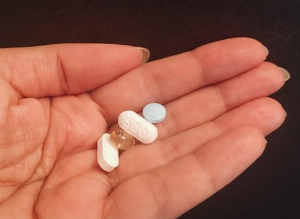Diabetes: how to read blood tests
Published 6 May 2019 • Updated 30 Sep 2020 • By Louise Bollecker
When you have a chronic disease such as diabetes, blood tests can be frequent. But do you know the values to be monitored for blood tests? Read our guide for patients with type 1 diabetes and type 2 diabetes.

The values presented in this article are reference values. However, they may vary according to the individual. They depend on the type of diabetes, treatment, age, the existence of complications and any associated pathologies. Refer to your doctor's instructions.
Diagnosing diabetes
The diagnosis of type 1 and 2 diabetes is based on a reference test, fasting blood glucose. It evaluates the blood sugar level.
Normal fasting blood glucose value: 0.7-1 g/L = 3.9-5.5 mmol/L
A single fasting blood glucose test greater than 2g/L (or greater than 11.1 mmol/L) is sufficient for diagnosis. When faced with a measurement between 2g/L and 1.26g/L (11.1mmol/L and 7mmol/L), a second examination will be necessary.
Once this examination has been carried out, to differentiate between type 1 diabetes and type 2 diabetes, the clinical field of each patient (symptoms, age, weight, family history, etc.) is used.
Monitor blood tests once diagnosed
As part of your diabetes follow-up, various biological parameters will be important to monitor in your blood tests.
The level of glycated hemoglobin (or HbA1c) to assess the stability of the disease
The usual values
Type 2 diabetes
Usual value of glycated hemoglobin (or HbA1C): less than 7%
Type 1 diabetes
Usual value of glycated hemoglobin (or HbA1C): less than 7,5%
Why this test?
The measured value reflects the average of the blood glucose levels over the last 3 months. This test is essential for diabetes monitoring because the objective is to have stable blood glucose values and thus limit complications.
The frequency of monitoring HbA1c levels
Every 6 months if the patient's glycemic control is achieved and stable.
Every 3 months if glycemic control is not achieved.
What is glycated hemoglobin?
Glycated hemoglobin is a hemoglobin molecule that has a glucose molecule attached. The concentration of glycated proteins reflects changes in blood glucose levels regardless of weight and physical activity.
A lipid check-up to monitor eating habits
Why this test?
An anomaly in the body's lipid (fat) levels is being investigated to assess the risk of cardiovascular complications that are more common in diabetic patients. Two parameters will therefore be measured, the cholesterol level and the triglyceride level.
The usual values of cholesterol levels
Usual value of total cholesterol: 1.6-2.0 g/L = 4.10-5.20 mmol/L
This value includes both types of cholesterol, "good cholesterol" also called HDL-cholesterol (High Density Lipoprotein-Cholesterol) and "bad cholesterol", LDL-cholesterol (Low Density Lipoprotein-Cholesterol).
Usual HDL cholesterol value: greater than 0.4 g/L = greater than 1 mmol/L
The higher the HDL cholesterol level, the better. Indeed, a value greater than 1.5 mmol/L is considered a cardiovascular protective factor. On the other hand, if this value is lower than the usual value, it is considered a cardiovascular risk factor.
Usual LDL cholesterol value: less than 1.6 g/L = 4.1 mmol/L
Unlike "good" cholesterol, high LDL cholesterol is a cardiovascular risk factor. The usual LDL cholesterol value varies according to the level of cardiovascular risk of each patient, but it is estimated that it should remain below 1.6 grams per litre of blood.
The usual value of the triglyceride level
Usual triglyceride value: between 1.6 and 2.0 g/L = between 0.40 and 1.70 mmol/L
Hypertriglyceridemia (too high a level of triglycerides) may be due to unbalanced diet (excessive consumption of fat, sugar and alcohol), the use of certain drugs or metabolic disorders including diabetes, overweight or obesity.
On the contrary, hypotriglyceridemia is rare and is caused either by a low-fat diet (malnutrition) or by an inherited disease.
The frequency of the lipid check-up
It is carried out every year. Depending on the results, the patient may have to change their diet to return to healthier levels.
A renal check-up to detect any impairment of renal function
Why this test?
In diabetic patients, kidney complications are common and most often without warning signs. Therefore, a regular kidney check-up is essential. The kidney check-up combines blood and urine tests. It therefore consists in determining the blood level of creatinine, which makes it possible to monitor the evolution of renal function.
The frequency of the renal check-up
Due to its importance, it is carried out at least once a year.
The usual values of creatinine levels
For Men
Usual value of creatinineemia in humans: between 7 and 13 mg/L = between 60 and 115 μmol/L
For Women
Usual value of creatinineemia in women: between 5 and 12 mg/L = between 45 and 105 μmol/L
A high creatinine value in the blood may be explained in cases of kidney failure or intense physical or muscle activity. A low creatinine value in the blood may be related to muscle atrophy associated with myopathy.
The usual values of creatinine clearance
Usual value of creatinine clearance: between 90 and 140 mL/min = between 1.50 and 2.30 mL/second
The clearance, or purification, of creatinine by the kidneys is used to assess the state of kidney function. A decreased creatinine clearance is a sign of renal failure and the lower its value, the more severe the renal failure will be.
A urinalysis to detect diabetic nephropathy
A urinalysis is also performed to measure the level of microalbuminuria. This analysis corresponds to the determination of albumin in the urine. It is an examination that allows early detection of a kidney problem. Indeed, the term microalbuminuria refers to the presence of too much albumin in the urine, which reflects impaired renal function.
Usual value of microalbuminuria: normal if it is less than 30 mg/24h or 30 mg/g according to the method
We speak of microalbuminuria the value is between 30 and 300 mg/24h or between 30 and 300 mg/g depending on the method.
The presence of microalbuminuria should be confirmed twice with at least one week interval. In the case of proven microalbuminuria, diabetic nephropathy will be referred to as renal impairment and a cardiovascular risk factor.
The usual values are to be qualified. First of all, talk to your doctor about it!
If you have already looked at a blood test report, you have seen that next to the result there are "usual values" or "reference values", with a lower and an upper limit. To define these reference values, biologists sample data from healthy populations. However, as in any statistical analysis, 5% of the sample is outside the norm. Therefore, being slightly outside the "reference values" does not always mean that there is a disease. Thus, in the face of an analysis that seems "abnormal", there is no need to worry without discussing it with the attending physician who prescribed the blood tests.
1 comment


 Facebook
Facebook Twitter
Twitter


